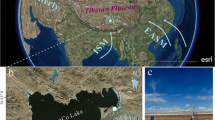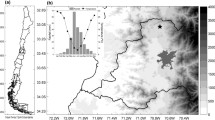Abstract
Based on the eddy covariance measurements from June 2011 to December 2013, the seasonal variations and the controls of water and CO2 fluxes were investigated over an alpine meadow in Lijiang, southwest China. The year 2012 had the largest total precipitation among years from 2011 to 2013 (1037.9, 1190.4, and 1066.1 mm, respectively). A spring drought event occurred from March to May 2012, and the peak normalized difference vegetation index (NDVI) in 2012 was the lowest. Throughout the whole year, net radiation (R n), vapor pressure deficit, and air temperature (T a) were the primary controls on evapotranspiration (ET), and R n is the most important factor. The influence of R n on ET was much more in the wet season (R 2 = 0.93) than in the dry season (R 2 = 0.28). In the wet season, the ratio of ET to equilibrium ET (ETeq) (0.92 ± 0.14; mean ± S.D.) did not show a clear seasonal pattern with NDVI when the soil water content (SWC) was usually more than 0.25 m3 m−3, indicating that ET could be predicted well by ETeq (or radiation and temperature). On half-hourly and daily scales, photosynthetic active radiation (PAR) and air temperature were the main meteorological factors in determining the net ecosystem production (NEP). The seasonal trends of NEP were closely related with the change of NDVI. The integrated NEP in the 2012 wet season (157.8 g C m−2 year−1) was 19.5 and 23.8 % lower than in the 2011 and 2013 wet season (207.0 and 196.1 g C m−2 year−1). The mean ET/ETeq for each of the wet seasons from 2011 to 2013 was 0.88. The 2012 spring drought and its reduction in NDVI decreased the total NEP significantly but had little effect on the total ET in the wet season. The different response of NEP and ET to the spring drought was attributed to the high SWC and small vapor pressure deficit during the wet season.








Similar content being viewed by others
References
Aires LMI, Pio CA, Pereira JS (2008) Carbon dioxide exchange above a Mediterranean C3/C4 grassland during two climatologically contrasting years. Glob Chang Biol 14:539–555
Bai YF, Wang J, Zhang BC (2012) Comparing the impact of cloudiness on carbon dioxide exchange in a grassland and a maize cropland in northwestern China. Ecol Res 27:615–623
Baldocchi D (2003) Assessing the eddy covariance technique for evaluating carbon dioxide exchange rates of ecosystems: past, present and future. Glob Chang Biol 9:479–492
Baldocchi D, Xu L, Kiang N (2004) How plant functional-type, weather, seasonal drought, and soil physical properties alter water and energy fluxes of an oak-grass savanna and an annual grassland. Agric For Meteorol 123:13–39
Beniston M, Rebetez M (1996) Regional behavior of minimum temperatures in Switzerland for the period 1979–1993. Theor Appl Climatol 53:231–243
Cao GM, Li YN, Bao XK (1998) The water retention capacity of the Mat-Cryic Cambisol in the Alpine regions. Soil 1:27–46 (in Chinese)
DAHV (Department of Animal Husbandry and Veterinary, Institute of Grasslands, Chinese Academy of Agricultural Sciences), CISNR (Commission for Integrated Survey of Natural Resources, Chinese Academy of Sciences) (1996) Rangeland resources of China. China Agricultural Science and Technology, Beijing
Du Q, Liu HZ (2013) Seven years of carbon dioxide exchange over a degraded grassland and a cropland with maize ecosystems in a semiarid area of China. Agric Ecosyst Environ 173:1–12
Falge E, Baldocchi D, Olson R (2001) Gap filling strategies for defensible annual sums of net ecosystem exchange. Agric For Meteorol 107:43–69
Fan ZX, Bräuning A, Thomas A, Li JB, Cao KF (2011) Spatial and temporal temperature trends on the Yunnan Plateau (Southwest China) during 1961–2004. Int J Climatol 31:2078–2090
Foken T, Wichura B (1996) Tools for quality assessment of surface-based flux measurements. Agric For Meteorol 78:83–105
Fu Y, Zheng Z, Yu G, Hu Z, Sun X, Shi P, Wang Y, Zhao X (2006) Depression of net ecosystem CO2 exchange in semi-arid Leymus chinensis steppe and alpine shrub. Agric For Meteorol 137:234–244
Fu YL, Yu GR, Sun XM, Li YN, Wen XF, Zhang LM, Li ZQ, Zhao L, Hao YB (2009) Environmental influences on carbon dioxide fluxes over three grassland ecosystems in China. Biogeosciences 6:2879–2893
Gu LH, Fuentes JD, Shugart HH, Staebler RM, Black TA (1999) Responses of net ecosystem exchanges of carbon dioxide to changes in cloudiness: results from two North American deciduous forests. J Geophys Res 104:31421–31434
Gu S, Tang YH, Du MY, Kato T, Li YN, Cui XY, Zhao XQ (2003) Short-term variation of NEE in relation to environmental controls in an alpine meadow on the Qinghai-Tibetan Plateau. J Geophys Res 108: doi:10.1029/2003JD003584
Gu S, Tang YH, Cui XY, Kato T, Du MY, Li YN, Zhao XQ (2005) Energy exchange between the atmosphere and a meadow ecosystem on the Qinghai-Tibetan Plateau. Agric For Meteorol 129:175–185
Gu S, Tang YH, Cui XY, Du MY, Zhao L, Li YN, Xu SX, Zhou HK, Kato T, Qi PT, Zhao XQ (2008) Characterizing evapotranspiration over a meadow ecosystem on the Qinghai-Tibetan Plateau. J Geophys Res 113: doi:10.1029/2007JD009173
Guo LN, He ZJ, Long X, Wang JZ, Wang LD, Li CX (2009) Soil characteristics and its classification system in Mt. Yulong, China. Guangxi Agric Sci 40:1177–1183 (in Chinese)
He YQ, Zhang D (2004) Climatic warming is the major reason for glacier retreat on Mt. Yulong, China. J Glaciol Geocryol 26:230–231 (in Chinese with English abstract)
Heitschmidt RK, Haferkamp MR (2003) Ecological consequences of drought and grazing on grasslands of the Northern Great Plains. In: McPherson G, Weltzin J (eds) Changing precipitation regimes and terrestrial ecosystems. University of Arizona Press, Tucson, pp 107–126
Hunt JE, Kelliher FM, McSeveny TM, Byers JN (2002) Evaporation and carbon dioxide exchange between the atmosphere and a tussock grassland during a summer drought. Agric For Meteorol 111:65–82
Kato T, Tang YH, Gu S, Cui XY, Hirota M, Du MY, Li YN, Zhao XQ, Oikawa T (2004a) Carbon dioxide exchange between the atmosphere and an alpine meadow ecosystem on the Qinghai–Tibetan Plateau, China. Agric For Meteorol 124:121–134
Kato T, Tang YH, Gu S, Cui XY, Hirota M, Du MY, Li YN, Zhao XQ, Oikawa T (2004b) Seasonal patterns of gross primary production and ecosystem respiration in an alpine meadow ecosystem on the Qinghai-Tibetan Plateau. J Geophys Res 109: doi: 10.1029/2003JD003951
Kato T, Tang YH, Gu S, Hirota M, Du MY, Li YN, Zhao XQ (2006) Temperature and biomass influences on interannual changes in CO2 exchange in an alpine meadow on the Qinghai-Tibetan Plateau. Glob Chang Biol 12:1285–1298
Klein JA, Harte J, Zhao X (2004) Experimental warming causes large and rapid species loss, dampened by simulated grazing, on the Tibetan Plateau. Ecol Lett 7:1170–1179
Knight DH (1994) Sagebrush steppe. In: Knight DH (ed) Mountains and plains: the ecology of Wyoming landscapes. Yale University Press, New Haven, pp 90–107
Kormann R, Meixner FX (2001) An analytical footprint model for non-neutral stratification. Bound-Layer Meteorol 99:207–224
Kwon H, Pendall E, Ewers BE, Cleary M, Naithani K (2008) Spring drought regulates summer net ecosystem CO2 exchange in a sagebrush-steppe ecosystem. Agric For Meteorol 148:381–391
Li SG, Asanuma J, Eugster W, Kotani A, Liu JJ, Urano T, Oikawa T, Davaa G, Oyunbaatar D, Sugita M (2005) Net ecosystem carbon dioxide exchange over grazed steppe in central Mongolia. Glob Chang Biol 11:1941–1955
Liu XD, Yin ZY, Shao XM, Qin NS (2006) Temporal trends and variability of daily maximum and minimum, extreme temperature events, and growing season length over the eastern and central Tibetan Plateau during 1961–2003. J Geophys Res-Atmos. doi:10.1029/2005JD006915
Lloyd J, Taylor JA (1994) On the temperature-dependence of soil respiration. Funct Ecol 8:315–323
Meyers TP (2001) A comparison of summertime water and CO2 fluxes over rangeland for well watered and drought conditions. Agric For Meteorol 106:205–214
Miranda AC, Miranda HS, Lloyd J, Grace J, Francey RJ, McIntyre JA, Meir P, Riggan P, Lockwood R, Brass J (1997) Fluxes of carbon, water and energy over Brazilian cerrado: an analysis using eddy covariance and stable isotopes. Plant Cell Environ 20:315–328
Monteith JL, Unsworth MH (1990) Principles of environmental physics, 2nd edn. Chapman and Hall, New York
Moore CJ (1986) Frequency response corrections for eddy correlation systems. Bound-Layer Meteorol 37:17–35
Priestley CHB, Taylor RJ (1972) On the assessment of surface heat flux and evaporation using large-scale parameters. Mon Weather Rev 100:81–92
Schotanus P, Nieuwstadt FTM, Bruin HAR (1983) Temperature measurement with a sonic anemometer and its application to heat and moisture fluxes. Bound Layer Meteorol 26:81–93
Shi PL, Sun XM, Xu LL (2006) Net ecosystem CO2 exchange and controlling factors in a steppe-Kobresia meadow on the Tibetan Plateau. Sci China-Earth Sci 49:207–218
Suyker AE, Verma SB (2001) Year-round observations of the net ecosystem exchange of carbon dioxide in a native tallgrass prairie. Glob Chang Biol 7:279–289
Vickers D, Mahrt L (1997) Quality control and flux sampling problems for tower and aircraft data. J Atmos Ocean Technol 14:512–526
Wang L, Liu H, Kezter B, Horn R, Bernhofer C (2012) Effect of grazing intensity on evapotranspiration in the semiarid grasslands of Inner Mongolia, China. J Arid Environ 83:15–24
Webb EK, Pearman GI, Leuning R (1980) Correction of flux measurements for density effects due to heat and water vapour transfer. Q J R Environ Soc 106:85–100
Wever LA, Flanagan LB, Carlson PJ (2002) Seasonal and interannual variation in evapotranspiration, energy balance and surface conductance in a northern temperate grassland. Agric For Meteorol 112:31–49
Wilczak JM, Oncley SP, Stage SA (2001) Sonic anemometer tilt correction algorithms. Bound-Layer Meteorol 99:127–150
Wilson K, Goldstein A, Falge E, Aubinet M, Baldocchi D, Berbigier P, Bernhofer C, Ceulemans R, Dolman H, Field C (2002) Energy balance closure at FLUXNET sites. Agric For Meteorol 113:223–243
Xu LK, Baldocchi D (2004) Seasonal variation in carbon dioxide exchange over a Mediterranean annual grassland in California. Agric For Meteorol 1232:79–96
Xu XD, Tao SY, Wang JZ, Chen LS, Zhou L, Wang XR (2002) The relationship between water vapor transport features of Tibetan Plateau-monsoon ‘large triangle’ affecting region and drought-flood abnormality of China. Acta Meteorol Sinica 60:257–267
Zhang MJ, He JY, Wang BL, Wang SJ, Li SS, Liu WL, Ma XN (2013) Extreme drought changes in Southwest China from 1960 to 2009. J Geogr Sci 23:3–16
Zhao L, Li Y, Xu SY, Zhou HK, Gu S, Yu GR, Zhao XQ (2006) Diurnal, seasonal and annual variation in net ecosystem CO2 exchange of an alpine shrubland on Qinghai-Tibetan plateau. Glob Chang Biol 12:1940–1953
Acknowledgments
This study was supported by the National Natural Science Foundation of China (grant No.: 41030106 and 41305012) and the Third Tibetan Plateau Scientific Experiment: Observations for Boundary Layer and Troposphere (GYHY201406001). We also greatly appreciate the staffs from Lijiang Meteorological Administration for their help in the maintenance of the measurements.
Author information
Authors and Affiliations
Corresponding author
Rights and permissions
About this article
Cite this article
Wang, L., Liu, H., Sun, J. et al. Water and carbon dioxide fluxes over an alpine meadow in southwest China and the impact of a spring drought event. Int J Biometeorol 60, 195–205 (2016). https://doi.org/10.1007/s00484-015-1016-8
Received:
Revised:
Accepted:
Published:
Issue Date:
DOI: https://doi.org/10.1007/s00484-015-1016-8




